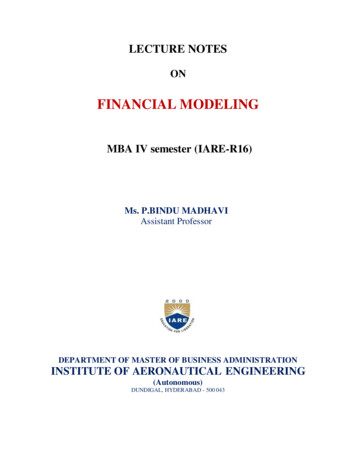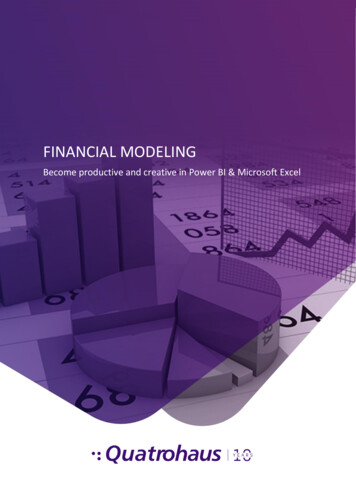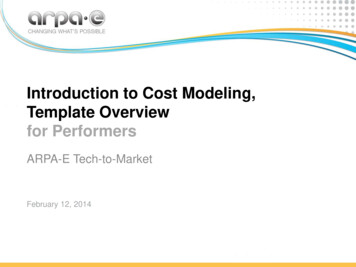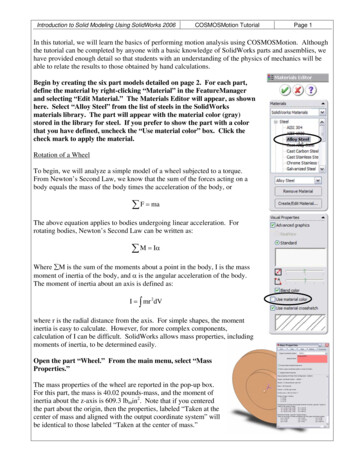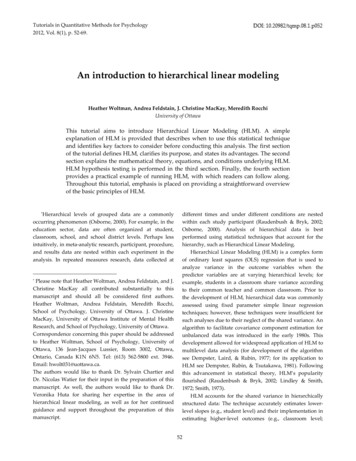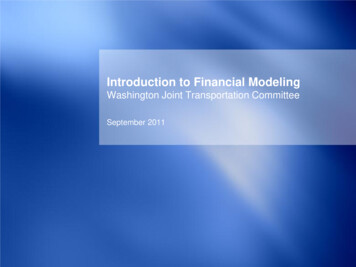
Transcription
Introduction to Financial ModelingWashington Joint Transportation CommitteeSeptember 2011
DRAFTIntroduction to Financial ModelingRelevance to WA JTC A tool that guides and supports decision making Evaluates the quantitative benefits and drawbacks ofdifferent financing and delivery approaches Aids Washington in determining whether it will receiveappropriate value Helps identify the method of project financing and facilitydelivery that is most likely to achieve the lowest costand/or best value Key tool used in the Value for Money (VfM) analysis
DRAFTIntroduction to Financial ModelingDefinition of Relevant TermsValue for Money analysis: Tool with the purpose of demonstrating whether a P3 solution is better thanthe chosen method of traditional delivery Comparison of the cost of delivery of a project under P3 against the costunder traditional deliveryPublic Sector ComparatorShadow Bid(PSC)Retained RisksRetained RisksAncillary CostsAncillary CostsFinancing CostsFinancing Costs Value of P3 RFP Bid NPV of P3 costsBase CostsBase Costs
DRAFTIntroduction to Financial ModelingDefinition of Relevant TermsPublic Sector Comparator (PSC) model: Risk adjusted, whole-life costs of a project if the project is procuredtraditionally DBB or DB normally the model used to model traditional delivery PSC is used to compare to the cost of P3 delivery PSC is stated in Net Present Value terms Estimation of project full cost and revenue under traditional delivery Consideration and quantification of project risks Use of discount rate
DRAFTIntroduction to Financial ModelingDefinition of Relevant TermsShadow Bid model: Cost of delivery of a project under the P3 approach Shadow Bid is effectively the hypothetical estimation of what the privatesector would bid in response to the P3 RFP Beyond the VFM analysis, Shadow Bid models are used to: Assess different scope or commercial terms Analyze financing structure Develop payment mechanisms
DRAFTIntroduction to Financial ModelingDefinition of Relevant TermsAvailability payment P3 model: Concessionaire designs, builds, finances, operates and maintains the facility overa period of time Receives a periodic payment as compensation. Payment is dependent upon: Availability – facility being available to users Performance – facility performing to standards specified in P3 agreement If facility is not available or performing to standards, then the concessionairereceives a deduction to the availability payment. The concessionaire may not receive any availability payment if unavailability / nonperformance is material. Tolls can still be collected on the facility; however, concessionaire is notcompensated directly from toll revenue (i.e., public sector retains revenue risk)
DRAFTIntroduction to Financial ModelingDefinition of Relevant TermsToll concession P3 model: Concessionaire designs, builds, finances, operates and maintains the facility overa period of time Concessionaire responsible for collecting toll revenue generated by the facility.Toll revenue compensates the concessionaire for costs incurred. Performance standards normally included in the P3 agreement Inability of concessionaire to meet performance standards can be grounds fortermination Concessionaire retains revenue risk (both upside and downside)
DRAFTIntroduction to Financial ModelingDefinition of Relevant TermsDiscount rate: A discount rate is needed to convert project cash flows into NPV Adjusting discount rate to reflect inherent risk in cash flow can be counterintuitive for costs – if a high discount rate is applied to high risk costprojections, the result will be a low NPV Generally, the values of risks are added/included in the cost projections The same discount rate is applied to cost projections of both P3 and PSC Choice of the discount rate: Government borrowing rate – Probably most widely used and easiest toexplain but often will not accurately reflect inherent risk in cash flows.Discount rate is from government’s perspective. Project level discount rate (Project WACC) – Discount rate is from theproject’s perspective reflective of risk inherent in cash flows. Choice of discount rate is a policy decision
DRAFTIntroduction to Financial ModelingFramework for VfM AnalysisThe methodology for developing a VfM analysis includes: Define procurement model and risk sharing Estimate project costs Estimate project revenuesProject inputs Identify and analyze project risks Assess the uncertainty around the cost estimates to arrive at risk-adjustedvalues Develop financial model and calculate net present value
DRAFTIntroduction to Financial ModelingDeveloping a Financial Model – Core Components Built in Microsoft Excel, usually consisting of numerousworksheets At its core, it consists of: Inputs Calculations Outputs Summary sheet for quick, “desktop” view of project Calculations are complex and interaction exists betweenworksheets Includes functionality to facilitate in-depth analysis
DRAFTIntroduction to Financial ModelingDeveloping a Financial Model – Core ComponentsInputsCalculationsOutputsUnit Tolls(Adjust to give targetreturns and ratios)Equit y Ret urnsTraff ic ForecastGovernm entFundingAncillaryRevenueProject RevenueOperat ing Expendit ureDebt ServiceCoverage Rat iosCapit al Expendit ureIndexat ionOperat ing CostAssum pt ionsConst ruct ion andLif ecycle CostAssum pt ionsFinancial CostAssum pt ionsFinancingNPV of CashFlow sFinancingRequirem ent s
DRAFTIntroduction to Financial ModelingDeveloping a Financial Model – InputsRevenuePSCBaseline projectionsConstruction Baseline cost projections for constructionof facility using DBB or DB modelO&MBaseline projections for O&M assumingWSDOT as providerLifecycleBaseline projections for lifecycleassuming ‘status quo’ approachTaxNot applicableFinancing InflationInflation rates for revenue, construction,O&MMust match shadow bid modelTenor ofanalysisFor toll projects: toll revenue-bondfinancing terms TIFIA For non-toll projects: traditional bond(GO or GARVEE) financing termsShadow Bid ModelBaseline projections considering “equity” viewProjections using a fixed-price DB modelBaseline projections for private O&M providerBaseline projections with impact of enhancedO&M to reduce lifecycle costs Federal, state, and local taxes Depreciation and impact on taxationPrivate finance terms for: Taxable bank/bond debt Tax-Exempt Private Activity Bonds TIFIA EquityInflation rates for revenue, construction, O&M To be determined Generally, for availability payment P3: avg. 30years Generally, for toll concession P3: avg. 50 years
DRAFTIntroduction to Financial ModelingDeveloping a Financial Model – Outputs Long-term cash flow analysis of project inputs Funding gap assessment over the project life Valuations in both year of expenditure and present dollarterms Financial capacity assessments for both taxable and taxexempt debt and private equity scenarios depending ondelivery option
DRAFTIntroduction to Financial ModelingDeveloping a Financial Model – Functionality Functionality within the model allows a user to analyze: Chosen private and public sector delivery options Private sector financing and public sector funding andfinancing solutions, including: PABs, TIFIA, equity, taxable bonds, bank debt and Stateand Federal grants Model can include “breakeven” analysis functionality Model can include NPV analysis functionality
DRAFTIntroduction to Financial ModelingDeveloping a Financial Model – the Process Coordinate with WA JTC to clarify scope of projects andcoordinate output of financial model Data and input collection, including “gap” analysis Sources of data to be confirmed Develop a financial model that is aligned with the level ofcomplexity and detail of the inputs
DRAFTIntroduction to Financial ModelingFinancial Model Inputs – Data SourcesProject: gProject: SR 509SourceRevenueConstructionO&MLifecycleFinancing
DRAFTIntroduction to Financial ModelingFinancial Model Inputs – Data SourcesProject: SR roject: I-5 Columbia River cing
DRAFTIntroduction to Financial ModelingFinancial Model Inputs – Data SourcesProject: Monroe ng
Develop financial model and calculate net present value Introduction to Financial Modeling Framework for VfM Analysis Project inputs . DRAFT Built in Microsoft Excel, usually consisting of numerous worksheets At its core, it consists of: Inputs Calculations Outputs Summary sheet for quick, “desktop” view of project Calculations are complex and interaction exists .

